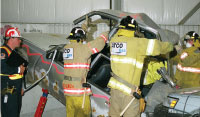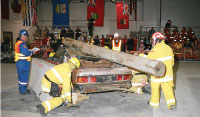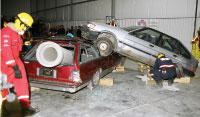
Features
Training
TERC challenge tests extrication specialists: Teams encouraged to compete in regional events
Gradually you come to, in a daze and confused. You hurt. The last thing you remember is the car headed toward you. Then, a crash. Panic sets in as you realize you’re trapped. You move your head, eyes searching for a way out. Then there’s a voice: Fire department. We’re here to help you.
April 9, 2008
By Randy Schmitz
Gradually you come to, in a daze and confused. You hurt. The last thing you remember is the car headed toward you. Then, a crash. Panic sets in as you realize you’re trapped. You move your head, eyes searching for a way out. Then there’s a voice: Fire department. We’re here to help you.
You peer over the now deflated airbag. On the other side of the smashed windshield is a firefighter.
“Please don’t move. Where do you hurt? What’s your name? We will have you out as soon as possible.”

|
 |
 |
| PHOTOS COURTESY RANDY SCHMITZ Top: Calgary fire cadets complete a roof-removal exercise during the Alberta regional TERC competition. Middle: The Parkland County team competes at the 2005 Alberta regional TERC event in Calgary with Brad Goodwin from Toronto Fire Services judging the event. Bottom: The Burlington (Ontario) Fire Department team competes in the Alberta regional limited pit event in 2005. The team was the overall winner. |
Panic subsides; you’re in good hands. There’s a rescue team at work to stabilize your injuries and get you out.
The team is trained in extrication, a skill that’s becoming more and more hazardous and complex as car manufacturers meet new passenger-safety standards to make their vehicles safer and more crash worthy.
One way rescuers can increase extrication proficiency is by attending vehicle extrication challenges.
Transport Emergency Rescue Committee (Canada)
The Transport Emergency Rescue Committee oversees all aspects of sanctioned extrication challenges in Canada and the U.S., including guidelines, policies and operations.
TERC’s mission statement is to serve as a competent source of guidance and infor-mation on transportation emergencies for those involved in providing emergency service.
TERC is a non-profit organization comprising emergency service personnel. There are subcommittees within TERC that deal with each aspect of the challenge, including judging, education, policies and bylaws, pit liaison, tools and equipment, auto manufacturers and executive committees.
The challenge
Every year since 1984, in Canada and the U.S., rescue personnel have assembled six-member teams to compete in simulated road accidents that test their skills, experience and knowledge. Firefighters from around the globe compete and share knowledge and ideas about vehicle extrication techniques and procedures.
Each team of six rescuers participates in two scenarios. Each scenario is set up with real vehicles being crushed together along with other props, such as fire hydrants, telephone poles, concrete barriers and any other object that could be involved in a real accident. A live “patient” then climbs into the wreckage and awaits rescue. The team is summoned to the area and the 20-minute timer starts.
The goal is to mitigate the hazards, stabilize the vehicle(s), stabilize the patient, and safely extricate the patient from the vehicle – all in 20 minutes.
During the so-called limited scenario, the team can use only limited hand tools to extricate the patient. During the unlimited scenario, teams can use hand tools and heavy hydraulic tools such as the Jaws of Life. Three judges mark various aspects of the team’s performance. There is a third option called the rapid scenario that can be added to a challenge; the time is reduced to 10 minutes and the exercise is designed to simulate a rapid-release situation that is life threatening, with time-critical injuries that are not treatable in the vehicle. The tool list is the same as the unlimited scenario.
The teams
To accomplish the goal, each team member plays an important role. The roles are:
Incident commander (1) – formulates the plan and oversees the progress;
Interior rescuer (2) – makes contact with patient and starts medical aid;
Tool specialists (3-4) – stabilize the vehicle and use tools to extricate the patient.
Judging
One judge follows the incident commander and rates performance based on control of the incident and plan of attack. Another judge follows the interior rescuer and awards marks based on how quickly the rescuer makes contact with the patient and his assessment, treatment and demeanour with the patient. Sometimes the patient is wired with a microphone and the medical judge wears a headset so he can hear the exchange between the patient and the interior rescuer. This allows the judge to more accurately monitor and evaluate the level of care. A third judge watches the overall scenario and marks the team based on how well the members work together, how comfortable they are with the equipment, the techniques they use and how effective they are.
The scores are then combined to give an overall score for each scenario.
Judging criteria
Each judge follows extensive assessing criteria to maintain
consistency. Some of the categories that are scored are size up, scene
stabilization command and control, vehicle stabilization, team
management, scene safety, tool knowledge and proper usage, rescuer
safety, medical control and efficiency to the end result.
Assessing a rescue scenario is no easy task and the judges must
continuously make every effort to evaluate fairly and remain
impartial.
Judges must have six years of fire service experience, attend a judging
workshop, shadow judge a set number of challenges and provide a letter
of endorsement from a TERC judge one level higher than the applicant,
who is familiar with the applicant’s qualifications.
| 2008 extrication challenges This year, the Alberta Vehicle Extrication Association (AVEA) and he Calgary Fire Department will co-host the 2008 Alberta Regional Extrication Challenge at the CFD Training Academy June 6-8. Along with the two-day challenge, this event includes a learning symposium, evening social events, silent auction and door prizes. The Calgary Fire Department has hosted successful challenges in the past. In 2005, teams from Burlington, Ont., and Fernie, B.C., came out to enhance their extrication skills. Calgary again encourages teams from across Canada and the northwestern U.S. to participate, share knowledge, expertise and ideas, meet new friends and have fun. For more information about this challenge, contact me at rwschmitz@shaw.ca or 403-669-0750. Regional TERC events For host contacts and other details, visit www.terccanada.ca , www.terc.us or www.Albertavx.com |
There are three levels of judging status: regional, national and international. To qualify for the next level of judging, a candidates must shadow a judge at the level they are trying to attain. Judges must also provide annual judging activity reports and pay a yearly fee to maintain their status.
Recently introduced is a judge critique form that each participating team can fill out at the end of the challenge to evaluate the judges. The feedback is reviewed by the TERC judges committee and the information is discussed with the challenge judges.
Want to host a challenge?
Each year, an emergency service department within each region or province hosts a regional extrication challenge. The host usually has about a year to plan and execute a challenge. A potential host department can request to put on an event or may be prompted at the annual awards banquet to step up to the plate.
Most departments require the year’s notice to raise between $5,000 and $25,000 to host the event. This figure depends on the number of teams that are part of that region and how extravagant the host chooses to make the event.
The host department relies heavily on sponsorship and in-kind support from local businesses. A portion of the budget will come from the challenge team registration fee, which is in the $450 to $500 range. A regional competition can effectively accommodate a maximum of 16 teams during an average two-day challenge.
National and international challenges are longer – usually three or four days – and require more planning and larger budgets as there are more teams.
Each zone or region sends its first place overall winner (and sometimes second place overall winner if there are spots available) from the previous year to compete in the following year’s national competition. The team entry fee for a national or international event is a minimum of $1,000 up to $1,500; this higher fee helps offset the already subsidized national or international challenge budget. The top placing regional teams wait to compete in the following year’s higher-level event to give them sufficient time to train and fundraise to cover travel costs.
Teams participating in TERC-sanctioned events must be members of TERC Canada or TERC USA. The annual fee to compete in one regional event is $60. It’s $150 to compete in as many challenges as a team wishes.
Tools and equipment
The challenge host supplies the tools and equipment with assistance from rescue-tool vendors such as Holmatro, Hurst, Genesis, TNT, Amkus, ResQTec, Ajax and Rescue 42, to name a few. These suppliers dedicate their tools, time and efforts to assist in the tool pit.
The tool list below is used to simulate what rescue personal can expect to have on a responding emergency rescue vehicle. This is a generic guide that the host will try to replicate as closely as possible.
Teams can bring their own, homemade, remanufactured tools or equipment but all items must be approved by the tool committee or head judge of the challenge. This encourages teams to be innovative and usually helps the judges to decide which team should receive the innovation award for new tools, techniques and/or methods.
Tools permitted in the limited and unlimited pits
| ITEM | Limited Pit Quantity | Unlimited Pit Quantity |
| Pry axe with or without can opener attachment | 1 | 1 |
| Flat head axe | 1 | 1 |
| Pick head axe | 1 | 1 |
| Bolt cutters | 1 | 1 |
| Pry bars, e.g. – F.E. bar, Haligan tool, etc. | 2 | 2 |
| Claw hammer | 1 | 1 |
| Ball-peen hammer | 1 | 1 |
| Sledgehammer | 1 | 1 |
| Rubber mallet | 1 | 1 |
| Channel lock pliers | 1 | 1 |
| Battery pliers | 1 | 1 |
| Assorted other pliers | 1 | 1 |
| Assorted screwdrivers | 1 | 1 |
| Assorted socket wrenches, standard and metric | 1 | 1 |
| Assorted wrenches, standard and metric | 1 | 1 |
| Assorted adjustable wrenches | 1 | 1 |
| Assorted vice grips | 1 | 1 |
| Hacksaws (six spare blades) | 2 | 2 |
| Assorted knives | 1 | 1 |
| Seatbelt cutter | 1 | 1 |
| Two-ton come-a-long, chain, cable or nylon with spare handles | 2 | 2 |
| Rescue chains, 12-foot certified grade with oblong ring, shortener and slip hook | 2 | 2 |
| Assorted chains | 2 | 2 |
| Nylon ratchet straps | 4 | 4 |
| Air chisel and six bits | 1 | 1 |
| Impact wrenches and ratchets, air or electric powered | 1 | 1 |
| High lift jacks | 2 | 2 |
| Reciprocating saws, air or electric powered (two recip saws maximum allowed in pit) | 2 | 2 |
| Glass saw, air or electric powered and manual | 2 | 2 |
| Spring loaded centre punch (furnish one for use) | 1 | 1 |
| Assorted cribbing | = | = |
| 25 wedges, 25 4×4, 25 4×6, etc. | = | = |
| Assorted patient-care items (blankets, collars, etc.) | = | |
| Soft, medium and hard board protection | = | = |
| Air lift bags – high, low, and medium pressure | 1 set | 1 set |
| Pike pole – six-foot | 1 | 1 |
| Stepladder up to 6-foot | 1 | 1 |
| Utility ropes or webbing straps (rope ½-inch diameter, minimum 10 feet in length) | = | = |
| Air bottles (four per team per scenario) | 4 | 4 |
Heavy hydraulics
| 1 – cutter | Choice of 1 | 1 set |
| 1 – spreader | Must be HAND powered | 1 set |
| 1 – combination tool | 1 set | |
| 1 – ram of each size | 1 set | |
| 2 – hydraulic taps (symo or two single-power plants) | 1 set | |
| 1 – hand pump | 1 set |
Print this page